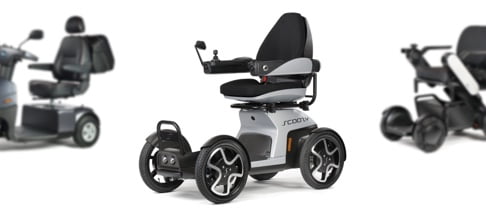Choosing between a folding mobility scooter and a fixed frame scooter can be confusing. It’s not just about whether it folds, it’s about how you want to live day-to-day. The right choice depends on where you’re going, how often you’re going, and how easy it needs to be to carry or store.
Let’s break it down properly.
What’s the difference between folding and fixed mobility scooters?
Folding scooters are compact and portable. Most can be folded down quickly and lifted into a car boot or stored in a small hallway or cupboard. Some even fit in tight spaces like under a desk or next to your armchair. When looking at TGA’s folding mobility scooters the Minimo is TGA’s perfect travel companion.
Fixed mobility scooters don’t fold; they’re built for sturdiness and a smoother ride. They tend to be heavier, more comfortable for longer journeys, and come with bigger batteries, seats and wheels.
Build and frame
- Foldable mobility scooters use lightweight materials like aluminium and often come with lithium batteries to keep the weight down.
- Fixed scooters have a rigid frame. That adds stability but makes them harder to lift or move without a ramp.
Portability and weight
- Folding models often weigh less than 30kg. Some are even lighter with lithium battery tech.
- Fixed scooters are not made to be lifted often. You’d need a ramp or vehicle hoist for transport.
Ease of storage
- Folding scooters go into cupboards, car boots, and even airplane cabins (if airline approved).
- Fixed scooters need dedicated storage space and often can’t be taken on public transport.
When is a folding mobility scooter the right choice?
Think about where you’ll use it most.
- Short trips to the shop or around the garden? A folding scooter is user-friendly.
- Getting it into a car boot? Easy. Many folding scooters collapse with one movement such as the Minimo Autofold.
- Public transport or airline travel? Folding wins again, many models are accepted by buses, trains, and planes (check lithium battery guidelines first).
Ideal for:
- Daily errands
- Indoor environments like shopping centres or supermarkets
- Tight spaces at home or in cafes
- Users who can lift or get help lifting the scooter
- Travel and portability needs
Where fixed mobility scooters make more sense
Fixed scooters start to shine when comfort and longer trips are your priority.
- Pavement scooters or Class 3 models (road legal) usually have better suspension, full seats with armrests, and a more powerful motor.
- If you’re using it for daily long-distance journeys or spend more than an hour at a time riding, a fixed model is probably better.
Ideal for:
- Longer journeys on pavements and roads
- Users with storage space at home
- Higher comfort needs
- Riders who won’t need to lift or fold the scooter often
Comparing comfort, safety features, and performance
Ride comfort and suspension
- Fixed scooters win here. They often include suspension for bumpier pavements and adjustable swivel seats for easier transfers.
- Folding scooters are improving, but many don’t have full suspension.
Safety features
- Most models have LED lights, horn, reflectors and adjustable armrests.
- Class 3 models (fixed) include indicators, mirrors and larger wheels for safety on roads.
Battery and performance
- Folding models often have a smaller battery, expect 10–15 miles on a single charge.
- Fixed scooters can reach 25–30 miles per charge, depending on the motor and weight carried.
- Speed: Class 2 scooters go up to 4mph, Class 3 can do up to 8mph (with a pavement setting limited to 4mph).
Key things to consider before buying
Ask yourself:
- Can I or someone else lift this into a car boot?
- Do I need it mainly for indoor use or longer outdoor journeys?
- Is the battery airline-friendly?
- Do I have enough storage space at home?
- How much seat support and comfort do I need?
- What’s my budget? Folding scooters with more features often cost more
If you’re unsure, try both types out. You might find folding suits your weekdays, but fixed is better for weekends or longer trips.
FAQs
Can folding scooters be used on pavements?
Yes, most folding scooters are Class 2 and built for pavement use. They’re limited to 4mph, which is perfect for walking pace.
Are folding scooters less safe than fixed ones?
Not necessarily. As long as you stick to the weight limits and don’t take them over rough terrain, they’re safe for everyday use. Fixed scooters are just better suited for longer, bumpier routes.
What’s the best scooter for air travel?
Look for folding scooters with removable lithium batteries under airline weight limits. Many scooters in the TGA range meet this.
Is it worth having both types?
Some people do. A folding scooter for short trips and travel, and a fixed scooter for daily comfort and longer distances.
So, which is right for you?
Choosing between a folding vs fixed mobility scooter depends on your routine, strength, and space. Folding scooters suit travel and tight spaces. Fixed scooters offer comfort and range. If you want everything you need for daily living, think about what matters more: portability or performance.
Need help picking the right mobility scooter? Explore our range of folding mobility scooters or road-legal pavement scooters.

